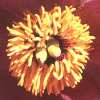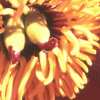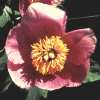accepted name (2005):
Paeonia officinalis subsp. microcarpa
1884
P. microcarpa, Boiss. and Reut., Pugillus, p. 3 ; P. peregrina var. leiocarpa, Cosson, Pl. Cret., p. 93 ; Willk. et Lange, Fl. Hisp., iii. 975.—Stems 1— 1 ½ foot long, 1-headed. Lower leaves with about thirty oblong, acute confluent segments 1/6 — 1/4 inch broad, very pubescent beneath. Flower solitary, the outer sepals not so compound as in humilis. Petals bright crimson. Follicles 2, glabrous, very spreading, smaller than in humilis.A native of the mountains of Spain. A very near ally of P. humilis. I am not aware that we have it in English gardens.
1890
Lynch
Sub-genus Paeon.
Herbaceous. Petals not leathery, large and expanding, much exceeding the sepals.
E. Leaves glaucous, or of very pale green above, generally of striking grey-green aspect; leaflets glaucous below, and very rarely without distinct pubescence, always divided, and with the lobes often fissured. (See figs. 30-33.)
I. Flowers distinctly stalked, not apparently sessile, and resting on the upper leaves.
* Carpels glabrous.
16. P. microcarpa, Boiss. et Reut.—
A very near ally of the preceding; the cultivated plants, so far as I have seen, not easily distinguished. The Cambridge plant has very red petioles, with leaflets narrower than those of humilis, very pubescent beneath. Mr. Baker describes the plant as having stems 1 to 1 1/2 foot long. Lower leaves, with about thirty oblong acute confluent segments, 1/2 to 3/4 inch broad, very pubescent beneath. Outer sepals not so compound as in humilis. Petals bright crimson. Follicles two, very spreading, smaller than in humilis. Mountains of Spain.
1923
Ascherson & Graebner Synopsis der mitteleuropäischen Flora 5, II, 546-558.Leipzig 1923
II. Fruchtblätter wenigstens zur Fruchtzeit verkahlend.
a. humilis. Blätter gross, die oberen doppelt 3theilig. Lappen der Blätter länglich bis länglich-oval, stumpf bis stumpflich, ziemlich kurz, unterseits zottig. Fruchtblätter dünn behaart bis verkahlend.
In Süd-Frankreich angegeben, die Angabe aber nach Rouy u. Foucaud (Fl. France I. 146) sicher irrthümlich durch Verwechselung mit anderen Formen, die Abart 2 im Departement Gard die Grenzen des Gebietes erreichend.
P. humilis Retz. Obs. III. 35 (1783). Koch Syn. ed. 2. 28. — P. peregrina var. humilis Koch in Flora XXIV. 2. 441 (1841). Huth in Engl. Jahrb. XIV. 270 (1891). — P. peregrina var. leiocarpa Coss. Not. pl. crit. II. 93 (1851). — P. microcarpa Boiss. u. Reut. Pugill. pl. nov. 3 (1852). Nym. Consp. 22 Suppl. 14. — P. peregrina Form. P. microcarpa Rouy u. Fouc. Fl. France 1.146 (1893). — P. feminea c. humilis Gürke in Richter-Gürke Pl. Eur. II. 402 (1903).
Ist nach Huth (a. a. 0.) vielleicht nicht von villosa zu trennen. —
Hierzu gehört:
2. leiocarpa.[Von gr. leios, glatt und gr. karpos, Frucht.] In allen Theilen kleiner. Blätter ziemlich klein, die oberen dreitheilig; die Lappen kurz, klein, stumpf bis spitzlich, unterseits behaart. Fruchtblätter kahl. — Westliches Süd-Frankreich. — P. paradoxa [beta] leiocarpa DC. Prodr. I, 66(1824) im engeren Sinne. — P. peregrina Forme P. leiocarpa Rouy u. Foucaud Fl. France I. 145 (1893). — Hierzu [beta] microphylla (Rouy a. Foucaud a. a. 0. |1898|). Blätter sehr klein.
(Verbreitung der Rasse humilis: Mediterranes Südwest-Frankreich; Spanien; Portugal.)
1946
Stern
P.humilis Retzius, Obs. Bot. 3, 35 (1783);
Syn. P.microcarpa Boissier & Reuter, Pugill. PI. Nov. 3 (1852) ; Amo y Mora, Fl. Fanerog. Penins. Iber. 6, 747 (1873) ; Baker in Gard. Chron., N. Ser. 21, 779 (1884) ; Mariz in Bull. Soc. Brot. 4, 112 (1886) ; Sampaio, Adic. e Corr. Fl. Portug. (in Bull. Soc. Brot., Ser. 2, 7), 30 (1931) ; non Salm-Dyck (1834).
1995
Cullen & Heywood in Tutin: Flora Europaea
(d) Subsp. microcarpa (Boiss. & Reuter) Nyman, Consp. 22 (1878) (P. microcarpa Boiss. & Reuter, P. humilis Retz., P. officinalis subsp. humilis (Retz.) Cullen & Heywood, P. paradoxa G. Anderson): Stems and petioles pubescent. Leaflets divided to not more than 1/3 of the distance to base. Follicles glabrous. S, W. Europe.
Fotos Hermann Fuchs
Fotos Josef Halda








